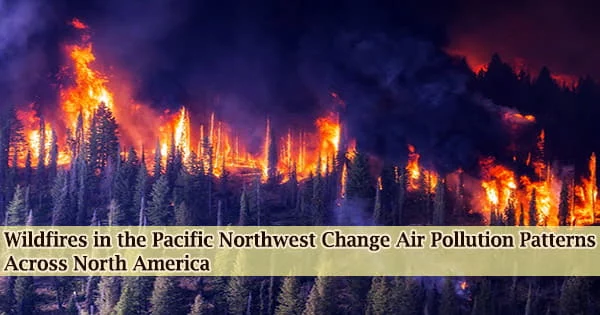According to recent research, larger and more severe wildfires in the Pacific Northwest are changing the seasonal rhythm of air pollution and triggering an increase in hazardous pollutants in August. According to the study, smoke is eroding clean air gains and creating possible health concerns to millions of people.
Researchers from the National Center for Atmospheric Research (NCAR) discovered that as wildfires expanded in August, levels of carbon monoxide, a chemical that signals the presence of other air pollutants, surged dramatically.
Carbon monoxide levels are typically lower in the summer due to chemical reactions in the atmosphere caused by changes in sunshine, therefore the fact that they have risen suggests the severity of the smoke’s effects.
“Wildfire emissions have increased so substantially that they’re changing the annual pattern of air quality across North America,” said NCAR scientist Rebecca Buchholz, the lead author. “It’s quite clear that there is a new peak of air pollution in August that didn’t used to exist.”
Although carbon monoxide is not a major health risk outside, the gas indicates the presence of more dangerous pollutants such as aerosols (airborne particles) and ground-level ozone, which forms on hot summer days.
The researchers employed satellite-based atmospheric chemistry data and global fire inventories to track wildfire emissions over the past two decades, as well as computer modeling to assess the smoke’s possible implications. They concentrated on three areas of North America: the Pacific Northwest, the Midwest, and the Northeast.
The findings were particularly startling, according to Buchholz, because carbon monoxide levels have been declining globally and across North America as pollution-control technologies have improved.
Wildfire emissions have increased so substantially that they’re changing the annual pattern of air quality across North America. It’s quite clear that there is a new peak of air pollution in August that didn’t used to exist.
Rebecca Buchholz
The study was published this week in Nature Communications. The U.S. National Science Foundation, NCAR’s sponsor funded the research in part. The paper was co-authored by researchers from the University of Colorado, Boulder; Columbia University; NASA; Tsinghua University; and Colorado State University.
Increasing impacts on air pollution
Due to a mix of climate change, rising development, and land-use restrictions, wildfires have been on the rise in the Pacific Northwest and other parts of North America. Fires are becoming a more significant source of air pollution, especially as emissions from human activities decrease due to more efficient combustion processes in automobiles and industrial buildings.
Buchholz and her colleagues used data from two NASA Terra satellite instruments to study the effects of fires: MOPITT (Measurements of Pollution in the Troposphere), which has been tracking carbon monoxide since 2002, and MODIS (Moderate Resolution Imaging Spectrometer), which detects fires and provides information on aerosols. They also looked at four wildfire emissions inventories that used MODIS data.
The researchers looked at MOPPIT data from 2002 to 2018, the last year for which complete observations were available at the time they started their research. The findings revealed an increase in carbon monoxide levels across North America in August, which coincided with the Pacific Northwest’s peak burning season.
According to the emissions inventories, the shift was most noticeable from 2012 to 2018, when the Pacific Northwest fire season became substantially more active. Aerosols also exhibited an increased trend in August, according to data from the MODIS instrument. The scientists removed other possible emission sources to ascertain the fires caused whether the elevated pollution levels.
Carbon monoxide levels were substantially lower upwind of the Pacific Northwest, over the Pacific Ocean, in August, indicating that pollution was not blowing in from Asia. They also discovered that fire season in the central United States and the Northeast did not correspond with an increase in pollution in August, indicating that local fires were not to blame.
They also looked at two fossil fuel emission inventories, which revealed that human-caused carbon monoxide emissions did not increase in any of the three study zones from 2012 to 2018.
“Multiple lines of evidence point to the worsening wildfires in the Pacific Northwest as the cause of degraded air quality,” Buchholz said. “It’s particularly unfortunate that these fires are undermining the gains that society has made in reducing pollution overall.”
Risks to human health
Wildfire smoke has been related to substantial respiratory difficulties, and it may also impact the cardiovascular system and decrease pregnancy outcomes, according to the study.
Buchholz and her co-authors utilized the Community Atmosphere Model with a Chemistry Component, a computer model developed by NCAR, to predict the flow of emissions from the Pacific Northwest fires and their impact on carbon monoxide, ozone, and fine particulate matter.
The simulations were run on the NCAR-Wyoming Supercomputing Center’s Cheyenne supercomputer. The findings revealed that the pollutants might harm over 130 million people, with 34 million in the Pacific Northwest, 23 million in the Central United States, and 72 million in the Northeast.
Although the study did not go into great detail on the health effects of the emissions, the scientists compared respiratory fatality rates in August in Colorado from 2002 to 2011 to the same month in 2012 to 2018. They chose Colorado, which is in the study’s central U.S. region, since respiratory fatality statistics were easily available.
They discovered that respiratory fatalities in Colorado increased considerably in August from 2012 to 2018, when fires in the Pacific Northwest but not in Colorado caused more pollution.
“It’s clear that more research is needed into the health implications of all this smoke,” Buchholz said. “We may already be seeing the consequences of these fires on the health of residents who live hundreds or even thousands of miles downwind.”





